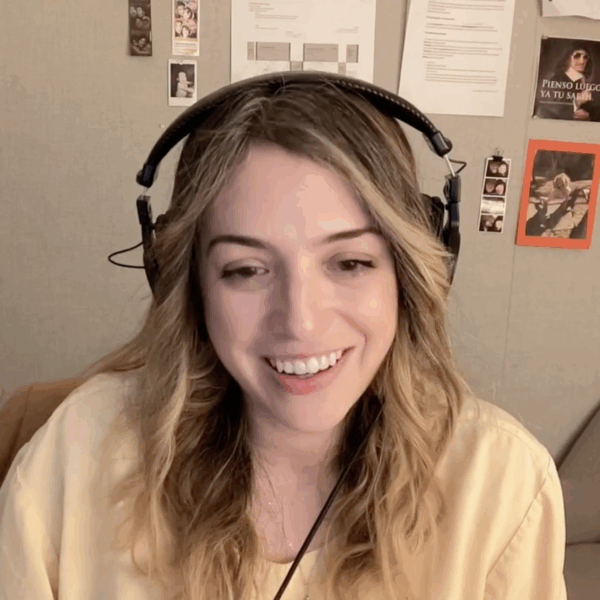On the latest episode of the Nieman Storyboard podcast, “This American Life” reporter and editor Nadia Reiman joins Storyboard Editor Mark Armstrong for a conversation about immigration, mass deportation under Trump’s presidency, and finding the human stories amid ongoing raids by U.S. Immigration and Customs Enforcement (ICE).
Reiman has worked for “This American Life” since 2018, and in 2019, she was part of the producing and reporting team for “The Out Crowd,” an episode examining the first Trump administration’s policy on asylum seekers, which was honored with the first-ever Pulitzer Prize in Audio Reporting. Before working at “This American Life,” she was a senior editor at “Latino USA” and producer for StoryCorps. She’s worked in radio production since 2005.
[ Follow us in Apple Podcasts, Spotify, or your favorite podcast app. ]
Reiman explains what she’s looking for in a story: “I want it to be human. At the end of the day, it’s all a bunch of humans doing stuff to humans. [I want listeners] to feel like they’re eye-to-eye with anyone, an immigration official or a random immigrant that they’ve never talked to.”
Using audio clips to illustrate different points, Reiman and Armstrong discussed three “TAL” stories from three different moments: “The Largest Deportation Operation in American History,” from November 2024, in which Jason Houser, the former chief of staff for ICE under President Biden, speculated how mass deportations might happen, after Trump was elected to a second term; “Solving for Where,” from April 2025, about a woman named Mari searching for her fiancé, a Venezuelan migrant who was taken by officers and sent to prison in El Salvador; and “Goodbye, Stranger,” from the Pulitzer-winning 2019 episode, which was produced by Reiman and reported by Molly O’Toole.
Each of the episodes presented unique challenges in both the reporting and writing, including the use of interpreters as well as voice actors to protect anonymous sources.
Reiman herself is an immigrant, born in Costa Rica and whose parents went to the U.S. to study. She became a U.S. citizen in 2010. “I think partially the reason why I am interested in making immigration reporting palatable for people is because I’ve been through the immigration system myself, and I know how nonsensical and obtuse and crazy it can be,” she said. “So if I can help people make sense of it, that feels important to me.”
The excerpts below are edited for length and clarity.
What Reiman is looking for in a ‘This American Life’ story:
I am in a place of luxury compared to my other immigration reporting colleagues that have to just jump and cover everything. I don’t feel like I have to jump and cover everything. I have more capacity and space where I can keep tabs on everything that’s happening and kind of start to put my finger on things that are changing, or we can say something bigger and hold out for that.
[That’s] in addition to all the things that we always look for in a story for “TAL,” which is we want to have a character, we want to be able to document them going through something, there has to be an action, there has to be kind of a clear “before and after” for that person. …
I want it to be human. At the end of the day, it’s all a bunch of humans doing stuff to humans. [I want listeners] to feel like they’re eye-to-eye with anyone, an immigration official or a random immigrant that they’ve never talked to.
How Reiman conducts interviews for ‘TAL’:
We’re really greedy with people’s time. I try to be really upfront with people when we go interview them and I’m like, “I’m going to talk to you, [and] I need at least three hours, and then maybe I’ll come back.” Often I just do it in chunks. I’ll do a three-hour interview, and then I’ll do another three-hour interview to end up with a 15-minute radio piece.
But I don’t know how else to do it in the way that we need. Our questions are: “Tell me exactly what you thought at that time, and then what did you think next? What was the first thing that jumped into your mind? And then how did that make you feel?” We try to get people to tell it to us like a movie. Sometimes people just kind of talk that way, and that’s pretty magical. But in general, we as humans don’t talk that way. We just answer the question. So you need a lot of guidance to get that kind of audio.
On the difference between law and policy in U.S. immigration:
A lot of the things in the immigration system don’t operate under rules as we understand them, as “legal” or “illegal” are not really terms that make sense in immigration, because so much of it is policy and practice and just like, “This is the way we’ve done it. There’s no written law that says we can’t or that we need to do it this way, but it’s just the way we’ve done it.” So a lot of the things that happen to people that are not immersed in it don’t make any sense. They’re like, “Is that legal?” And you’re like, “Well, yes, but also maybe not. But also it’s a policy. So it’s not a law, but it’s a policy.” There’s discretion built all over the system.
On adding depth and agency to people’s stories:
I think often when you’re reporting on stories where so many tragic and hard things are happening to a group of people in the community, if you just talk about what happened, you end up accidentally talking about what happened to them. And so it’s people that things happen to. … And I’m not saying that some of these things don’t happen to them outside of their control. That’s different. There are things happening to them that are outside of their control.
But I think the way that you tell people’s stories, you end up kind of making them a little bit two- dimensional if you don’t also show the internal process, their choices, their thoughts. And so I think getting a sense of them as people, and really laying out how active Mari was from the beginning and how much of a go-getter she is, and how she just doesn’t stop moving, and getting her to really explain to me who Mikael [her Venezuelan fiancé] is because I didn’t get to meet him. … That helps you see them as full people that are going through something rather than people that something is happening to, that have no real motion as characters.
On working with an interpreter:
[For the “Solving for Where” segment in the “Chaos Graph” episode,] I did all the interviews in Spanish with Mari the whole time. And then once I had selected the clips that we were going to use, then I went with Anayansi Diaz-Cortes, who’s this amazing reporter who was also an amazing live interpreter. I don’t know how she does it because it’s a completely hard skill. I’ve tried to do it for people and I can’t do it, but she’s really good at it. And so she did the live interpretation. She was so good at not only the accuracy, but also getting the emotion and the feeling of the things that Mari was saying. So it made it super easy and it made it feel so much livelier to the English speakers once they heard it.
So that’s the way I do it. I also like to leave in little bits of Spanish sometimes untranslated, if they’re small enough you can follow, because I feel like it’s a nice little thing for people that speak the language to hear a little bit of it. Also, it’s a way for you to hear the original essence of the person, even when you have somebody else’s voice over it. We think about that a lot in the show — how to use interpreters and how to mix in voices in a way that you’re being authentic to the feeling of the person and also to the words, the content.
On using voice actors to keep sources anonymous:
[For the “Goodbye Stranger” segment on “The Out Crowd” episode:] It was a matter of public interest what was happening. And so we felt pretty sure that we wanted to figure out a way to do the story and we didn’t know how. We talked about all kinds of ways. Do we distort their voice? Do we pitch-shift it? How do we do it? Ultimately all of the processing we could do at that time to disrupt someone’s voice could be undone fairly easily. And if you make it to the point where it can’t be undone, it’s so robotic that you don’t get a sense of the person anymore. So we opted for working with actors.
It’s funny because I remember one of the first edits that we did of it, the feedback from somebody here was like, “Oh, I think that actor was too upset in this part. Can we get them to redo it so they’re not as upset?” And I was like, “That’s not the actor yet. That’s just the person. They’re just really upset.”
On the unique voice of ‘This American Life’ in this moment:
I’ve always liked the tone of “TAL.” It’s something that I’ve always felt was nice and honest and refreshing. I wasn’t as sharp of a writer when I first came [to the show] because I wasn’t used to writing in that way. There’s a lot of things that [host and co-creator Ira Glass] does really artfully. … And to the show’s credit, I’ve never felt like I couldn’t say something that I wanted to say that I had evidence for. There’s kind of a “say it with your chest” thing that I think is happening more and more in the show that I always respond to in the media that I like and that I consume. So I’m happy that we can do that.
Reading & Listening List: Authors, Stories, Podcasts, and Reporters Mentioned
- “This American Life”
- “The Largest Deportation Operation in American History” (Nadia Reiman, “This American Life,” November 2024)
- Zoe Chace
- Alix Spiegel
- “A Massachusetts student arrested by ICE on his way to volleyball practice has been released” (CNN, 2025)
- “Solving for Where” (Nadia Reiman, “This American Life,” April 2025)
- Laura Starecheski
- Anayansi Diaz-Cortes
- Ira Glass
- Miki Meek
- “Goodbye, Stranger” (Molly O’Toole, “This American Life,” 2019)
- “Latino USA”
- Maria Hinojosa
- “Nadia’s First Time” (Nadia Reiman, “Latino USA,” 2012)
- Jamelle Bouie
- M. Gessen
- Caitlin Dickerson
- Brit Bennett
- Jonathan Blitzer
- JP Brammer
- Jia Tolentino
- “The Daily”
- “The Ezra Klein Show”
- “Up First”
- “The Retrievals”
- Susan Burton
- “Autocracy in America”
Show Credits
Hosted and produced by Mark Armstrong
Associate producer: Marina Leigh
Episode editor: Kelly Araja
Audience editor: Adriana Lacy
Promotional support: Ellen Tuttle
Operational support: Paul Plutnicki, Peter Canova
Nieman Foundation interim curator: Henry Chu
Music: “Golden Grass,” by Blue Dot Sessions (www.sessions.blue)
Cover design by Adriana Lacy
Nieman Storyboard is presented by the Nieman Foundation for Journalism at Harvard.
***
Subscribe to Storyboard
Get insights into the craft of journalism and storytelling in your inbox, delivered on Fridays.




